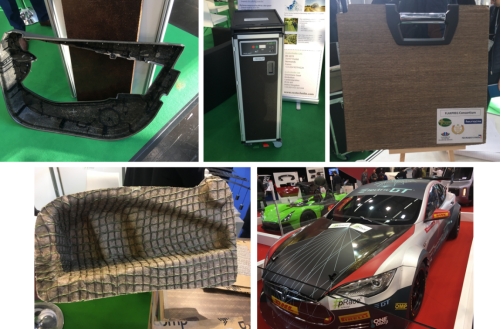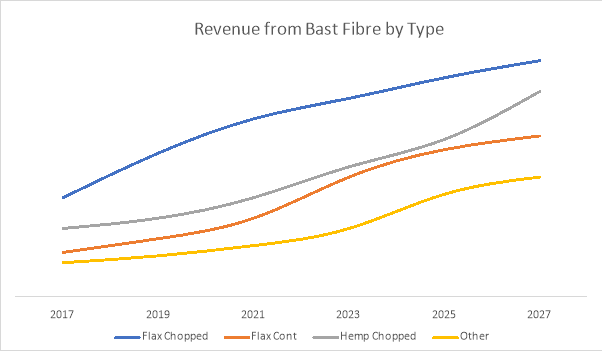
The bio-composite market cannot grow fast enough: report
January 22, 2018
By IDTechEx
Jan. 22, 2018 - Fibre reinforced polymers (FRPs) are predominantly made of synthetic fibres, such as glass or carbon, and a petrochemically sourced thermosetting resin or thermoplastic matrix. However, natural fibres and resins are on the rise because of their beneficial properties, competitive cost, legislative drivers, and consumer preferences. IDTechEx forecasts the revenue for bast fibres used in composite parts to exceed $140 million by 2027, which would have been greater still if the supply could be grown fast enough to match the burgeoning demand.
 Photos taken by IDTechEx analysts of flax fibres used in a variety of parts. A car door interior (top left)
Photos taken by IDTechEx analysts of flax fibres used in a variety of parts. A car door interior (top left) Wood fibres have been extensively used in composite materials for applications such as garden decking, but an emerging field of high performance bast fibres are gaining interest. These bast fibres include flax, hemp and jute and are immediately attractive as they provide comparable or improved tensile strength and stiffness to that of E-glass fibre, as well as contain favourable vibration dampening and non-abrasive properties.
The cost of bast fibres is not significantly higher than that of glass fibres, particularly for the short/chopped variants, but as with all materials there are a few notable downsides including high levels of moisture absorption, poor matrix adhesion, as well as the potential impact on the land. There are some key innovations for the fibre-matrix interface that will stop bast fibre composites from being held back, particularly surrounding the promising use of plasma treatment technologies. See a previous article for more about the other downsides of FRPs.
Profitable bast fibres also give the opportunity for farmers to diversify, and hemp is particularly beneficial as it can grow effectively on unfavourable land. Legislation is changing around growth restrictions of hemp in North America and this makes it more attractive and therefore IDTechEx forecasts the market to rise at a higher rate in the mid to long term as a result.
10-year market forecast for bast fibres by different type. Source Composites 2017-2027: Innovations, Opportunities, Market Forecasts
The main reason that bast fibres and natural resins are being talked about so much is due to the sustainability advantages, as industries look to improve their Life Cycle Assessments (LCA). Although the natural fibres are not biodegradable or reusable when embedded in synthetic resins, and many of the natural resins are also not biodegradable because of artificial catalysts used, they still deviate from (sometimes toxic) petrochemically sourced resin precursors.
The main commercial applications have been in the automotive sector and in sports equipment. The automotive sector makes good use of short bast fibres for the interior of car doors (see top left photo below) to provide lightweight sound and vibration dampening. Ecotechnilin are the market leaders for short flax fibre products; they currently have capacity for 6,000-7,000 tpa with plans to expand in the near-future. Their main market is automotive interiors, but they will be used for the trolleys on airplanes (see top centre photo) having demonstrated they can withstand 9G acceleration testing. Reflecting the demand around this industry, IDTechEx were also told that Ecotechnilin had to turn down a very large order from IKEA, as meeting the required volumes would be a challenge.
Continuous bast fibres are also gaining momentum: a product called flaxpreg (see top right photo) developed by Faurecia (with partners) is used for trunk floors and has a very large demand from 2018 onwards. Composites Evolution have developed a unidirectional flaxtape and Bcomp use a flax cross-hatch (see bottom left photo) with improved stiffness proposed for automotive interiors, to pick just a few.
There are regular high-profile examples, extending from the hemp body car made by Henry Ford in 1941 through to the concept car with a flax roof and bonnet (see bottom right photo) and the world’s first completely biocomposite car (called Lina) revealed earlier this year, which demonstrates the huge potential for biocomposites, it also helps dispel the myth that they cannot be used for structurally significant parts.
As previously mentioned, there is an emerging interest in bioresins but many of the current solutions only contain a fraction of biosourced material within an otherwise synthetic material matrix. Pond is a start-up that could show everyone the way. They have developed a starch-based bioresin that due to favourable adhesion removes the need for a binder when used with natural fibres. The removal of this binder negates the cost premium of the natural resin and improves the specific modulus by approx. 20%. As a result, big volumes are just around the corner and IDTechEx were told that this resin would be used in an automotive interior part from as early as Q2 2018.
For more information about the use of FRPs in the automotive industry then see a previous article here.
IDTechEx view biocomposites as a key emerging area within the fibre composite world. Many of the highest volume industries are circulating with intent and there is an increasing amount of funding programmes and anticipation arising in this field. For more information on natural fibres and resins, including players, manufacturing, and forecasts see the report from IDTechEx Composites 2017-2027: Innovations, Opportunities, Market Forecasts.
IDTechEx’s research into biocomposites was carried out in collaboration with students at the University of Cambridge, who were working towards a master’s degree in engineering for sustainable development.
For more see www.IDTechEx.com/composites and find out more about IDTechEx at www.IDTechEx.com.
IDTechEx guides your strategic business decisions through its Research and Events services, helping you profit from emerging technologies. We provide independent research, business intelligence and advice to companies across the value chain based on research activities and methodologies which provide data sought by business leaders, strategists and technology scouts to aid their critical business decisions. To discuss your needs please contact us at research@IDTechEx.com or see www.IDTechEx.com.
Print this page